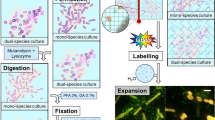Abstract
Biofilms are communities of bacteria living embedded in a highly hydrated matrix composed of polysaccharides, proteins, and extracellular DNA. This life style confers numerous advantages to bacteria including protection against external threats. However, they also contribute to increase bacterial resistance against antimicrobials, an issue particularly relevant in dangerous infections. Due to the complexity of the matrix, few information is present in the literature on details of its architecture including the spatial distribution of the macromolecular components which might give hints on the way the biofilm scaffold is built up by bacteria. In this study, we investigated the possibility to combine well-established microbiological procedures with advanced microscopies to get information on composition and distribution of the macromolecular components of biofilm matrices. To this, confocal microscopy, diffraction-limited infrared (IR) spectral imaging, and atomic force microscopy (AFM) were used to explore biofilm produced by a clinical strain of Klebsiella pneumoniae. IR imaging permitted to have clues on how the biofilm grows and spreads on surfaces, and the local distribution of the components within it. Through the analysis of the pure component spectra, it was possible to assess the chemical and structural composition of the saccaridic matrix, confirming the data obtained by NMR. It was also possible to follow the time course of biofilm from 6 up to 48 h when the biofilm grew into a 3-dimensional multi-layered structure, characteristic of colonies of bacteria linked together by a complex matrix. In addition, nanoFTIR and AFM investigations allowed the estimation of biofilm growth in the vertical direction and the morphological analysis of bacterial colonies at different time points and the evaluation of the chemical composition at the nanoscale.







Similar content being viewed by others
References
Flemming H-C, Wingender J, Szewzyk U, Steinberg P, Rice SA, Kjelleberg S. Biofilms: an emergent form of bacterial life. Nat Rev Microbiol. 2016;14:563.
Costerton JW, Lewandowski Z, Caldwell DE, Korber DR, Lappin-Scott HM. Microbial biofilms. Annu Rev Microbiol. 1995;49:711.
Branda SS, Vik Å, Friedman L, Kolter R. Biofilms: the matrix revisited. Trends Microbiol. 2005;13:20.
Flemming H-C, Neu T, Wozniak DJ. The EPS matrix: the “house of biofilm cells”. J Bacteriol. 2007;189:7945.
Fux CA, Costerton JW, Stewart PS, Stoodley P. Survival strategies of infectious biofilms. Trends Microbiol. 2005;13:34.
Birarda G, Holman EA, Fu S, Weikel K, Hu P, Blankenberg FG, et al. Synchrotron infrared imaging of advanced glycation endproducts (AGEs) in cardiac tissue from mice fed high glycemic diets. Biomed Spectrosc Imaging. 2013;2:301.
Li B, Zhao Y, Liu C, Chen Z, Zhou D. Molecular pathogenesis of Klebsiella pneumoniae. Future Microbiol. 2014;9:1071.
Munoz-Price LS, Poirel L, Bonomo RA, Schwaber MJ, Daikos GL, Cormican M, et al. Clinical epidemiology of the global expansion of Klebsiella pneumoniae carbapenemases. Lancet Infect Dis. 2013;13:785.
Cescutti P, De Benedetto G, Rizzo R. Structural determination of the polysaccharide isolated from biofilms produced by a clinical strain of Klebsiella pneumoniae. Carbohydr Res. 2016;430:29.
Benincasa M, Lagatolla C, Dolzani L, Milan A, Pacor S, Liut G, et al. Biofilms from Klebsiella pneumoniae: matrix polysaccharide structure and interactions with antimicrobial peptides. Microorganisms. 2016;4:26.
Whitfield C, Richards JC, Perry MB, Clarke BR, MacLean LL. Expression of two structurally distinct D-galactan O antigens in the lipopolysaccharide of Klebsiella pneumoniae serotype O1. J Bacteriol. 1991;173:1420.
Merritt JH, Kadouri DE, O’Toole GA. Growing and analyzing static biofilms. Curr Protoc Microbiol. 2005 Jul;Chapter 1:Unit 1B.1.
Heydorn A, Nielsen AT, Hentzer M, Sternberg C, Givskov M, Ersbøll BK, et al. Quantification of biofilm structures by the novel computer program COMSTAT. Microbiology. 2000;146:2395.
Vorregaard M. Comstat2 - a modern 3D image analysis environment for biofilms. Master thesis, Technical University of Denmark (DTU), 2008.
Lupi S, Nucara A, Perucchi A, Calvani P, Ortolani M, Quaroni L, et al. Performance of SISSI, the infrared beamline of the ELETTRA storage ring. J Opt Soc Am B. 2007;24:959.
Armitano J, Mejean V, Jourlin-Castelli C. Gram-negative bacteria can also form pellicles. Environ Microbiol Rep. 2014;6:534.
Lewis AT, Jones K, Lewis KE, Jones S, Lewis PD. Detection of Lewis antigen structural change by FTIR spectroscopy. Carbohydr Polym. 2013;92:1294–301.
Socrates G. Infrared and Raman characteristic group frequencies: tables and charts. 3rd ed. Chichester: Wiley; 2004.
Probst AJ, Holman HY, DeSantis TZ, Andersen GL, Birarda G, Bechtel HA, et al. Tackling the minority: sulfate-reducing bacteria in an archaea-dominated subsurface biofilm. ISME J. 2013;7:635.
Schlafer S, Meyer RL. Confocal microscopy imaging of the biofilm matrix. J Microbiol Methods. 2017;138:50.
Mandal DK, Bhattacharyya L, Koenig SH, Brown RD, Oscarson S, Brewer CF. Studies of the binding specificity of concanavalin A. Nature of the extended binding site for asparagine-linked carbohydrates. Biochemistry. 1994;33:1157.
Kaewpijit S, Le Moigne J, El-Ghazawi T. Automatic reduction of hyperspectral imagery using wavelet spectral analysis. IEEE Geosci Remote Sensing. 2003;41:863.
Roggo Y, Edmond A, Chalus P, Ulmschneider M. Infrared hyperspectral imaging for qualitative analysis of pharmaceutical solid forms. Anal Chim Acta. 2005;535:79.
Neu TR, Manz B, Volke F, Dynes JJ, Hitchcock AP, Lawrence JR. Advanced imaging techniques for assessment of structure, composition and function in biofilm systems. FEMS Microbiol Ecol. 2010;72(1):1–21.
Neu TR, Swerhone GDW, Lawrence JR. Assessment of lectin-binding analysis for in situ detection of glycoconjugates in biofilm systems. Microbiology. 2001;147:299.
Acknowledgements
We thank Dr. Philip Schäfer from NEASPEC GmbH for the support during these first measurements.
Funding
This study was funded by the University of Trieste (FRA 13 and FRA15). Images in this paper were generated at the Light Microscopy Imaging Centre (LMIC) of the University of Trieste - Life Sciences Department, funded as detailed at www.units.it/confocal.
Author information
Authors and Affiliations
Corresponding author
Ethics declarations
Conflict of interest
The authors declare that they have no conflicts of interest.
Additional information
Publisher’s note
Springer Nature remains neutral with regard to jurisdictional claims in published maps and institutional affiliations.
Electronic supplementary material
ESM 1
(PDF 230 kb)
Rights and permissions
About this article
Cite this article
Birarda, G., Delneri, A., Lagatolla, C. et al. Multi-technique microscopy investigation on bacterial biofilm matrices: a study on Klebsiella pneumoniae clinical strains. Anal Bioanal Chem 411, 7315–7325 (2019). https://doi.org/10.1007/s00216-019-02111-7
Received:
Revised:
Accepted:
Published:
Issue Date:
DOI: https://doi.org/10.1007/s00216-019-02111-7




